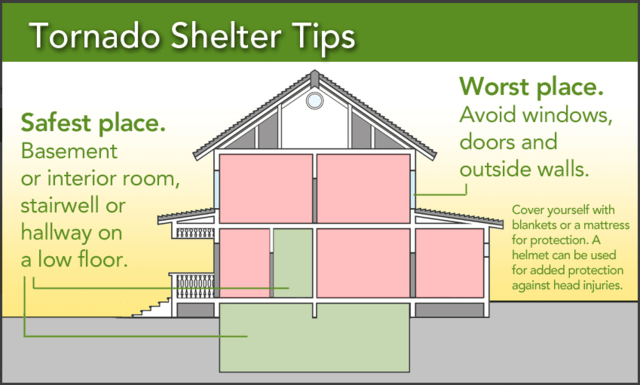
Sheltering during severe weather conditions is the best way to stay safe. Community shelters and dedicated individual storm shelters are optimal places to be during a severe weather event. In reality, not everyone has access to a dedicated storm shelter but choosing a good location in a sound structure is a good option. In a severe weather event, a properly chosen location in a well-built structure with a solid foundation is the next best thing to a dedicated shelter.
To learn how to take shelter in a variety of ways click FEMA's Shelter-in-Place-Pictogram
Tornados
If you are:
In a sturdy structure, such as a residence or small building:
Go to a pre-designated area such as a safe room, basement, storm cellar, or the lowest building level.
- If there is no basement, go to the center of a small, interior room on the lowest level (closet, interior hallway) away from corners, windows, doors, and outside walls.
- Put as many walls as possible between you and the outside.
- Get under a sturdy table and use your arms to protect your head and neck.
- In a high-rise building, go to a small interior room or hallway on the lowest floor possible.
- Put on sturdy shoes and a bicycle helmet or similar helmet to protect your head, if possible.
- Do not open windows.
- Keep your mobile phone with you.
- Cover yourself with heavy blankets or a mattress
Not in a sturdy structure:
There is no single research-based recommendation for what last-resort action to take because many factors can affect your decision. You must evaluate your options and the hazard expected to narrow down your best options. Possible actions include:
In a manufactured building such as a mobile home:
Get out immediately and go to a pre-identified location such as the lowest floor of a sturdy, nearby building or a storm shelter. Mobile homes, even if tied down, offer little protection from tornadoes. You must plan for this ahead of time!
If outside:
- Immediately get to a sturdy structure if possible. If not possible, get into a vehicle, buckle your seat belt, and try to drive to the closest sturdy structure or shelter. Never try to outrun a tornado in traffic congestion. If your vehicle is hit by flying debris while you are driving, pull over and park.
- A vehicle is not a “safe” place to be during a tornado but may be better than nothing, only use it if there is no other option available. Put the seat belt on and cover your head with your arms and a blanket, coat, or other cushion if possible.
- If no vehicle or structure is available, lie in an area noticeably lower than the level of the roadway or ground level and cover your head with your arms and a blanket, coat, or other for protection if possible.
- Do not get under an overpass or bridge. You are safer in a low, flat location.
- Watch out for flying debris. Flying debris from tornadoes causes most fatalities and injuries.
Earthquakes
Similar to a tornado it is important to take shelter. When you feel shaking or get an alert, protect yourself from falling objects. Just like a tornado, stay away from windows or outside walls and cover/protect yourself from falling objects with a pillow or table. Avoid the area around large bookshelves, TVs, large hanging objects, and other large furniture like china cabinets. If you are nearby, a walk-in tornado shelter may be an option as chimneys and large tree branches can fall.
If Possible

DROP where you are, onto your hands and knees. This position protects you from being knocked down and reduces your chances of being hit by falling or flying objects.
COVER your head and neck with one arm and hand.
- If a sturdy table or desk is nearby, crawl underneath for shelter.
- If no shelter is nearby, crawl next to an interior wall.
- Stay on your knees; bend over to protect vital organs.
HOLD ON until the shaking stops.
- Under shelter: hold on to it with one hand; be ready to move with your shelter if it shifts
- No shelter: hold on to your head and neck with both arms and hands.
Adapt to You Situation
If you have difficulty getting onto the ground, or cannot get back up again without help, then follow these recommendations:

- If you are in a recliner or bed: Cover your head and neck with your arms or a pillow until the shaking stops.
- If you use a cane: DROP, COVER, and HOLD ON or sit on a chair, bed, etc. and cover your head and neck with both hands. Keep your cane near you so it can be used when the shaking stops.
- If you use a walker or wheelchair: LOCK your wheels (if applicable). If using a walker carefully get as low as possible. Bend over and COVER your head/neck with your arms, a book, or a pillow. Then HOLD ON until the shaking stops.
For more information or to print the above information Click Here
Radiation Emergency
Also like a tornado, for a Radiation Emergency go inside and seek an inner and/or lower room to help shield you from exposure. Be prepared to stay inside for at least 24 hours. Stay tuned for updated instructions from emergency response officials through TV, Radio, Social Media, and TuscALERT. If exposed the person or pets should shower with soap and water and discard clothing.
Remember for Radiation:
- Time: less time spent near the source = less radiation received
- Distance: Greater distance from source = less radiation received
- Shielding: Behind shielding from source = less radiation received
Other Resources:
- For more information from the CDC Click Here
- For a Video on what to do Click Here
- For FEMA's Guide Sheet on Nuclear Explosion Click Here


Chemical or Hazmat
If taking shelter in a chemical or hazmat emergency Click Here for some steps you can take.
Further information can be found on FEMA’s emergency preparedness website.
